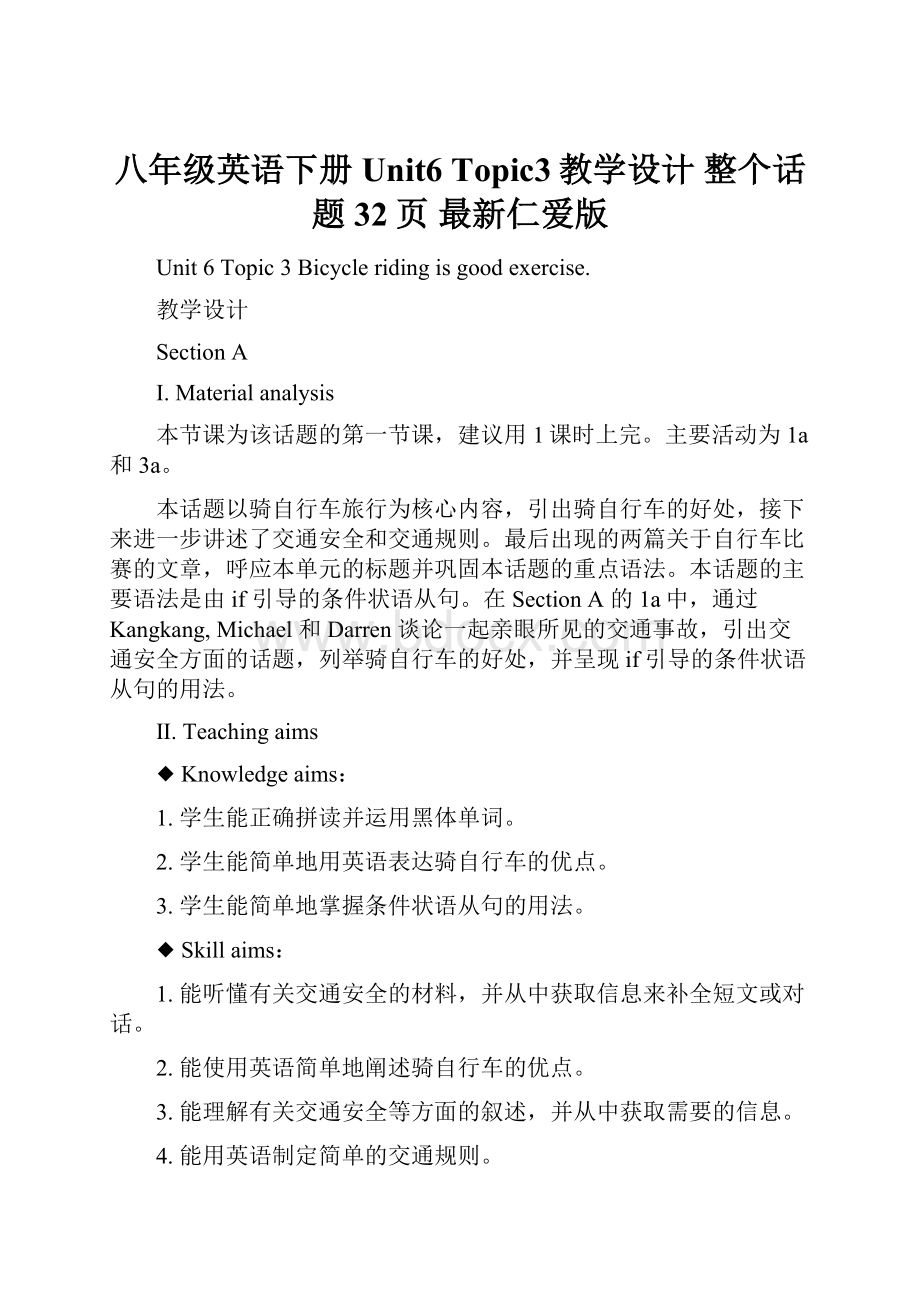八年级英语下册Unit6 Topic3教学设计 整个话题32页 最新仁爱版.docx
《八年级英语下册Unit6 Topic3教学设计 整个话题32页 最新仁爱版.docx》由会员分享,可在线阅读,更多相关《八年级英语下册Unit6 Topic3教学设计 整个话题32页 最新仁爱版.docx(43页珍藏版)》请在冰豆网上搜索。

八年级英语下册Unit6Topic3教学设计整个话题32页最新仁爱版
Unit6Topic3Bicycleridingisgoodexercise.
教学设计
SectionA
Ⅰ.Materialanalysis
本节课为该话题的第一节课,建议用1课时上完。
主要活动为1a和3a。
本话题以骑自行车旅行为核心内容,引出骑自行车的好处,接下来进一步讲述了交通安全和交通规则。
最后出现的两篇关于自行车比赛的文章,呼应本单元的标题并巩固本话题的重点语法。
本话题的主要语法是由if引导的条件状语从句。
在SectionA的1a中,通过Kangkang,Michael和Darren谈论一起亲眼所见的交通事故,引出交通安全方面的话题,列举骑自行车的好处,并呈现if引导的条件状语从句的用法。
Ⅱ.Teachingaims
◆Knowledgeaims:
1.学生能正确拼读并运用黑体单词。
2.学生能简单地用英语表达骑自行车的优点。
3.学生能简单地掌握条件状语从句的用法。
◆Skillaims:
1.能听懂有关交通安全的材料,并从中获取信息来补全短文或对话。
2.能使用英语简单地阐述骑自行车的优点。
3.能理解有关交通安全等方面的叙述,并从中获取需要的信息。
4.能用英语制定简单的交通规则。
◆Emotionalaims:
学会遵守交通规则,树立安全意识和环保意识。
Ⅲ.Thekeypointsanddifficultpoints
Keypoints:
1.谈论骑自行车的优点。
2.初步掌握条件状语从句的用法。
Difficultpoints:
写出关于交通事故的短文。
Ⅳ.Learningstrategies
在完成听力任务的过程中,学会关注你需要的目标词汇。
Ⅴ.Teachingaids
Computermultimediaprojector,thepicturesoftrafficaccidents,thepicturesofthepassengersandthepicturesofenvironmentalpollution.
Ⅵ.Teachingprocedures
Step
Interactionpattern
Studentactivity
Teacheractivity
Introduction
(8minutes)
1.Thewhole
classwork.
2.Thewhole
classwork.
3.Groupwork.
4.Thewhole
classwork.
5.Thewhole
classwork.
1.Focustheirattention
ontheteacher.
2.Studentsreadthe
passageabouttheir
experiencesofgettinglost.
3.Studentsmakea
surveyingroups.
4.Studentsreportthe
resultsofthesurvey.
5.Studentsobservethepictureandguess.
1.Greetthestudentsandgetthemreadyforlearning.
2.Theteacherasksthe
studentstoreportthe
homework.Letthe
studentsreadthepassageabouttheirexperiencesofgettinglost.
3.Theteacherletsthe
studentsmakeasurveyingroups:
(1)Howdoyouusuallygotoschool?
(2)Whydoyougotoschoolby/on…?
4.Theteacherletsthe
studentsfromdifferent
groupsreporttheresultsofthesurvey.
5.Theteachermakesa
summaryandleadstothenewlesson:
Mostofusgotoschoolbybike,andKangkang,Michael,JaneandDarrenalsolikeridingbikestoschool.Nowlet’slookatthepictureof1aandguess:
whataretheytalkingabout?
Presentation
(10minute)
1.Thewhole
classwork.
2.Thewhole
classwork.
3.Thewhole
classwork.
4.Individual
work.
5.Thewhole
classwork.
6.Individual
work.
1.Studentscheckthe
guess.
2.Studentswatchthe
flashandunderlinethenewwords.
3.Studentsreadthenewwords,andthenlearnthenewwordswith
thehelpoftheteacher.
4.Studentsreadthe
sentencesof1band
understandthegeneral
ideas.
5.Studentslistentothe
recordingandmarkT
orF.
6.Studentscheckthe
answers.
1.Theteacherplaysthe
flashof1a.Askthe
studentstowatchthe
flashtoknowaboutthegeneralmeaningoftheconversation,andthenchecktheguess.
2.Theteacherplaystheflashagainandasksthestudentstounderlinethenewwords.
3.Theteacheraskstwo
studentstotellthenewwords.Teachthenewwordspassengerandpollutionbyshowingthepicturesofthepassengersandthe
environmentalpollution.Teachthenewwordanywherebyshowingthewordeverywhere.
Teachthewordcrazybyshowingthewordmad.
4.Theteacherletsthestudentsreadthesentencesof1bandunderstandthegeneralideas.
5.Theteacherplaysthe
recordingof1aandletsthestudentslistencarefully,andthenmarkTorF.
6.Theteacheraskstwo
studentstogivethe
answers.
Consolidation
(10minutes)
1.Thewhole
classwork.
2.Thewhole
classwork.
3.Groupwork.
4.Thewhole
classwork.
5.Individual
work.
6.Thewhole
classwork.
7.Groupwork.
1.Studentsreadthe
conversationaftertherecordingsentenceby
sentence.
2.Studentstrytofollowthespeed,payingattentiontothepronunciationandintonation.
3.Studentsdiscussin
groupstofindoutthedifficultpointsandsumupthemainpoints.
4.Studentsunderlinethemainpointsintheirbooksandmakesomenotes.
5.Studentswritedown
threeadvantagesof
cycling.
6.Volunteersgivetheir
answers.
7.Studentsactoutthe
conversationof1ain
groupsof4.
1.Theteacherplaysthe
recordingsentenceby
sentence.
2.Theteacherplaysthe
recordingwithout
stopping.
3.Theteacherasksthe
studentstolearningroupstofindoutthedifficultpoints
intheconversation.Atlastletthemsumupthemainpointsoftheconversation.
4.Theteachermakesa
summarytoexplainthekeypointsanddifficultpointstothestudents:
(1)get/beusedto(doing)sth.
(2)beafraidof(doing)sth.
(3)Ifpeopleobeythetrafficrules,therewillbefeweraccidents.条件状语从句。
(4)airpollution
(5)It’s+adj.+todosth.
5.Theteacherasksthestudentstoread1aandwritedownthreeadvantagesofcycling.Encouragethemtoaddtheirownideas.
6.Theteacherletstwostudentsgivetheiranswers.Finish1c.
7.Theteacherasksthestudentstoactouttheconversationof1aingroupsof4.
Practice
(10minutes)
1.Groupwork.
2.Individual
work.
3.Individual
work.
4.Thewhole
classwork.
5.Thewhole
classwork.
6.Thewhole
classwork.
7.Thewhole
classwork.
1.Studentsdiscussthe
advantagesand
disadvantagesofridingbikesingroups.
2.Studentsreporttheirdiscussion.
3.Studentsreadthe
sentencesof2.
4.Studentslistentothe
recordingandfillintheblanks.
5.Studentslistenagain
andchecktheir
answers.
6.Studentscheckthe
answerswiththe
teacher.
7.Studentstalkaboutthereasonswhymore
peopleinChinause
bicycles.
1.Theteacherasksthestudentstodiscusstheadvantagesanddisadvantagesofridingbikesingroups.
Teachthenewworddisagreebycomparingwiththewordagree.
(1)Offertheexpressions:
(2)Cyclingcan…
(3)It’seasyto…
(4)Iagree/disagreewithyou.Ithink…
2.Theteacherasksfourstudentsfromdifferentgroupsto
reporttheirresultsofdiscussion.
3.Theteacherasksthestudentstoreadthesentencesof2.
4.Theteacherplaysthe
recordingof2sentencebysentence.Askthestudentstolistenandfillintheblanks.
5.Theteacherplaysthe
recordingof2without
stopping.
Askthestudentstolisten
againandchecktheir
answers.
6.Theteacherletstwoor
threestudentsgivetheir
answers.
7.Theteacherletsthe
studentstalkaboutthe
reasonsformorepeople
inChinausingbicycles.
Letthemknowabout
moreadvantagesofusing
bicycles.Tellthestudentsthatweshouldproducelesswasteandlearntoprotectourenvironment.
Production
(7minutes)
1.Thewhole
classwork.
2.Groupwork.
3.Thewhole
classwork.
4.Thewhole
classwork.
5.Thewhole
classwork.
6.Thewhole
classwork.
7.Individual
work
1.Studentsobservethepicturesof3acarefully.
2.Studentstalkaboutthepicturesingroupsand
completethesentences.
3.Studentstelltheir
answers.
4.Studentsreportthe
storytothewhole
class.
5.Studentslearntohavethesenseofsafety.
6.Studentssummarize
SectionAwiththe
teacher.
7.Studentsfinishthe
homeworkafterclass.
1.Theteacherasksthe
studentstoobservethe
picturesof3acarefullyandunderstandthemeanings
basedonthegivenwords.
2.Theteacherasksthe
studentstotalkaboutthepicturesingroupsandcompletethesentences.
Teachthenewwordriderbyadding–(e)rbehindthewordride.
3.Theteacherasksthree
studentstogivetheir
answers.
4.Theteacherasksthe
studentsfromdifferent
groupstoreportthestory
tothewholeclass.
5.Theteachershowsthe
picturesofsometrafficaccidents.Tellthemthat
theymustbecarefulon
thewaytoschoolandon
theirwayhome,andthe
safetymustcomefirst.
6.Theteachershowsthe
summarytothestudents.
7.Theteacherassigns
homework:
(1)Reviewthesummary
afterclass.
(2)Askthestudentsto
givesomeadviceonhowtopreventtrafficaccidents.
(3)PreviewSectionB.
TeachingReflection
Thestudentsrealizetheterribleresultsofthetrafficaccidents.Nowtheyknowthatit’sveryimportanttofollowthetrafficrules.Andtheyknowabouttheadvantagesofcycling.Theycanunderstandtheusageofadverbialclausesofconditionbriefly.
Ⅶ.Blackboarddesign
Unit6EnjoyingCycling
Topic3Bicycleridingisgoodexercise.
SectionA
1.get/beusedto(doing)sth.
2.beafraidof(doing)sth.
3.Ifpeopleobeythetrafficrules,therewillbefeweraccidents.条件状语从句
4.airpollution
5.It’s+adj.+todosth.
6.agree→disagree
Unit6Topic3Bicycleridingisgoodexercise
教学设计SectionB
Ⅰ.Materialanalysis
本节课建议用1课时上完。
主要活动为1a和2a。
本课通过Kangkang和Michael谈论一起后果严重的交通事故,进而继续讨论交通安全方面的话题,从而了解基本的交通规则,通过2a,2b和3b的学习活动,继续深入学习if引导的条件状语从句的用法。
培养学生遵守交通规则,树立安全意识。
Ⅱ.Teachingaims
◆Knowledgeaims:
1.学生能用英语简单地表述交通规则。
2.学生能掌握条件状语从句的用法。
3.学生能通过单词的重读判断句子表意的重点。
◆Skillaims:
1.能听懂有关交通规则和交通安全的材料,并从中获取信息来补全短文或对话。
2.能简单地用英语表达交通规则。
3.能理解有关交通规则和交通安全等方面的叙述,并从中获取需要的信息。
4.能用英语制定简单的交通规则。
◆Emotionalaims:
学会遵守交通规则,树立安全意识。
Ⅲ.Thekeypointsanddifficultpoints
Keypoints:
1.谈论交通规则。
2.进一步掌握条件状语从句的用法。
Difficultpoints:
写出关于遵守交通规则的短文。
Ⅳ.Learningstrategies
通过单词的重读判断句子表意的重点。
Ⅴ.Teachingaids
Computermultimediaprojector,ahelmet.
Ⅵ.Teachingprocedures
Step
Interactionpattern
Studentactivity
Teacheractivity
Introduction
(8minutes)
1.Thewhole
classwork.
2.Thewhole
classwork.
3.Groupwork.
4.Thewhole
classwork.
5.Thewhole
classwork.
1.Focustheirattention
ontheteacher.
2.Studentsreporttheirhomeworktoreviewtheknowledgeof
SectionA.
3.Studentsdiscussin
groupsonhowto
preventthetraffic
accidents.
4.Studentsreportthe
resultsofthediscussion.
5.Studentsobservethe
pictureandpreparefor
the